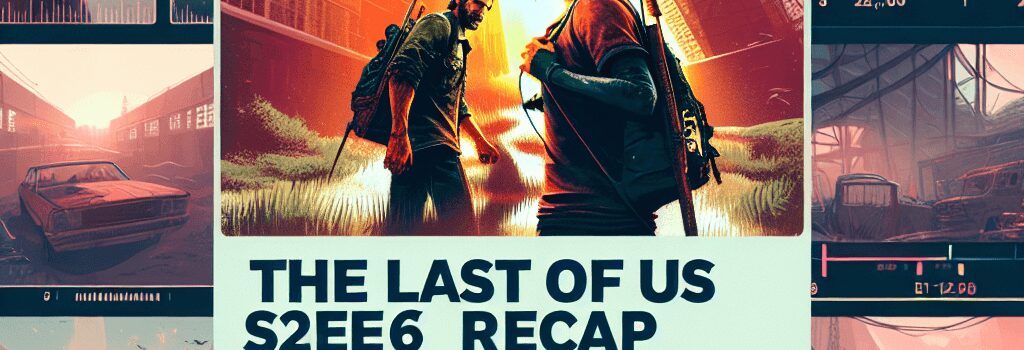The Last of Us S2E6 Recap: Joel’s Return and Production Insights

Warning: This recap contains heavy spoilers for Season 2, Episode 6 of HBO’s The Last of Us. Watch the episode first for a fresh experience.
Looking Who’s Back!
After the sudden cliffhanger of Pedro Pascal’s Joel reappearance in Episode 5, Season 2, Episode 6 (“Childhood Remnants”) delivers a rich, flashback-driven narrative that fleshes out the generational trauma behind Joel’s protective instincts. Beyond the emotional beats that fans know from the games, this episode showcases state-of-the-art production techniques—4K HDR cinematography, advanced LED volume virtual sets, and Dolby Atmos sound design—that elevate the storytelling to a new technical plateau.
1. Flashback Framing: Trauma to Tenderness
The episode opens on a dusty Arizona homestead circa 2003, captured on an Arri Alexa Mini LF at 6.5K resolution with Panavision Ultra Vista lenses. Cinematographer Michael Slovis uses a 2.39:1 aspect ratio to contrast the wide-open family farm with the claustrophobic cityscapes of later scenes. Joel’s archaic farmhouse—built on a 500×500 px LED backdrop—evokes a lost world, and the Dolby Vision HDR grade intensifies the dusty golds of golden hour.
“We wanted to translate the game’s ‘golden moment’ palette into live action,” said Slovis. “That meant pushing our dual-ISO Arri sensors to maintain highlight detail in the midday sun.”
2. Actor Insights: Building the Joel We Know
- Pedro Pascal (Joel Miller): On reprising a younger Joel, Pascal worked closely with the show’s dialect coach to adopt a more tentative, Midwestern-inflected drawl before evolving into the gruff survivor voice we know.
- Tony Dalton (Joel’s Father): Known for his role as Lalo Salamanca in Better Call Saul, Dalton explores a layered performance that balances stern patriarchal discipline with genuine remorse.
Key Scenes and Technical Specs
3. Science Museum Sequence
Ellie’s wide-eyed exploration of the dilapidated California Science & Technology Museum is recreated using a 180° LED volume, powered by 4× 8K projectors running at 60 fps. This virtual set allowed for dynamic reflections in the Apollo module’s plexiglass—critical for maintaining immersion. The show’s VFX supervisor, Joel Whist, noted that each interactive console was rigged with Unity–driven touchscreens to react in real time under Ellie’s fingertips.
4. The Porch Confrontation
Serving as the emotional fulcrum of the episode, “The Porch Scene” was shot in a single 12-minute take, using a Motus Gyro-stabilized camera crane to move seamlessly among characters. Sound designer Phillip Gould layered 7.1-channel Ambisonic ambience with faint cricket chirps, heightening the sense of isolation. The colorist then dialed back midtones in Davinci Resolve Studio to underscore the scene’s somber mood.
New Sections for Deeper Analysis
5. Virtual Production Pipeline
HBO’s Stage 16 at Warner Bros. employed a bespoke LED volume system—70 ft wide × 30 ft tall—rendering live Unreal Engine backgrounds. According to the VFX Art Director, real-time ray tracing was used to simulate accurate sunlight angles, reducing the need for extensive post production compositing. The result: believable environmental reflections on character costumes and practical set pieces.
6. Sound Design & Music Integration
Composer Gustavo Santaolalla returned to score the flashbacks, blending his signature ronroco theme with atmospheric synth pads to bridge the decades. In post, HBO’s sound team mixed the episode in Dolby Atmos, giving dialogue clarity in wide exterior shots while preserving low-frequency tension during intimate moments.
7. Adaptation Choices: Game vs. Screen
- Compressed Timeline: The series condenses multiple flashbacks into this single episode, whereas The Last of Us Part II game spreads them across segments for pacing.
- Expanded POV: New camera angles—like over-the-shoulder shots inside the Apollo capsule—offer novel perspectives not present in the game.
- Dialogue Tweaks: Showrunners Craig Mazin and Neil Druckmann refined Joel’s “baby girl” lines to underscore the unhealthy found-family dynamic while maintaining emotional heft.
Conclusion: Balancing Fan Service with Narrative Momentum
Episode 6 succeeds on two fronts: it gives die-hard fans the Porch Scene they’ve anticipated since the Season 1 finale while leveraging cutting-edge production technology. Yet it also raises questions about story pacing in Season 2: could a fuller season of flashbacks—and fewer big-bad cliffhangers—have delivered deeper character arcs? As the series returns to Ellie’s journey without Joel, viewers can appreciate not only the narrative stakes but the sophisticated hardware and software—cameras, VFX engines, and audio codecs—that bring this world to life.